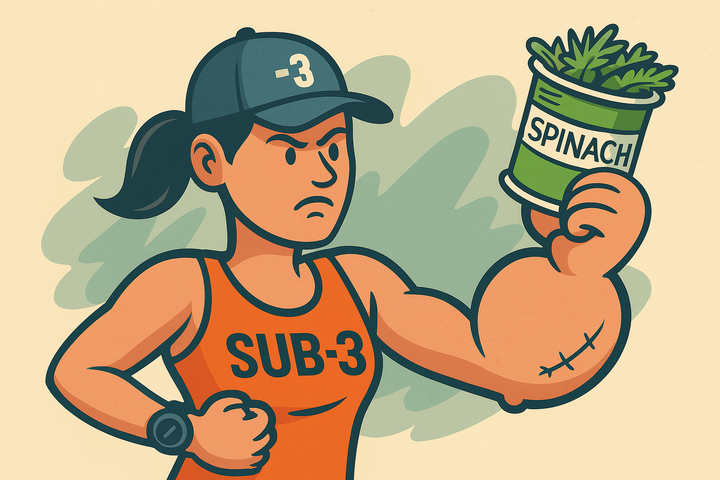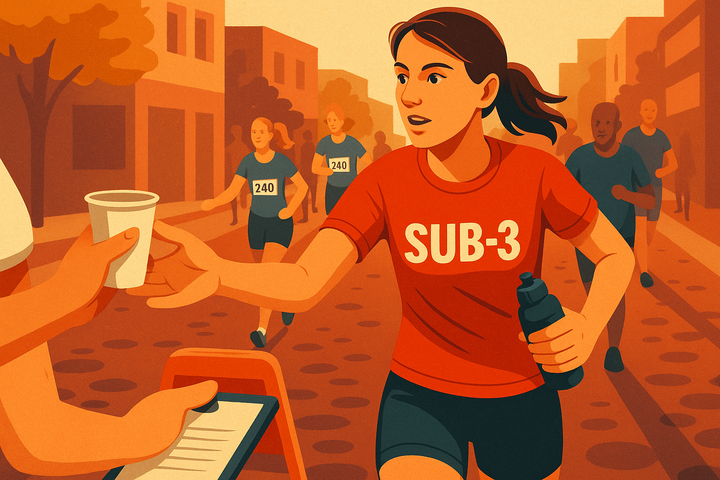5 ways to use caffeine to enhance your sub-3 performance
The one legal performance enhancer that could make the biggest difference to your marathon effort.

Stand near the front of any sub-3 starting pen and you’ll notice it straight away: the jittery legs, the twitching fingers, the nervous energy buzzing through the crowd. Sure, it’s partly nerves. But more than anything, it’s caffeine.
The average sub-3 runner is caffeinated to the hilt – and rightly so. Caffeine is one of the most consistently effective, well-researched, and widely legal performance enhancers available to endurance athletes. It’s explicitly endorsed by the International Olympic Committee (IOC), which notes that it enhances endurance, power output, time trial performance, and even perceived exertion – meaning it can make hard efforts feel a little less hard.
Of all the supplements I’ve tried – from beetroot juice (for nitrates) to creatine – caffeine is the one I wouldn’t race without. I’ve even sacrificed sleep to fit it in. Evening races, for example, often leave me wired until the early hours – but I’ll still take my full dose, because the performance benefits outweigh the recovery trade-off.
So how can you use caffeine effectively – and safely – for a sub-3 marathon?
1. Get The Dose Right – For You
Most research suggests a dose of 3 to 6 mg of caffeine per kilogram of body weight for endurance performance. That’s about 240 to 480mg for an 80kg runner – equivalent to 3–6 strong cups of coffee, or 4–8 caffeine gels, depending on the brand.
But this isn’t a case of ‘more is better’. The upper end of the range can cause side effects – especially in those not used to caffeine. Common issues include:
- Jitters and anxiety
- Increased heart rate
- Gastrointestinal distress
- Sleep disruption
Some runners also tend to need to go to the toilet a lot after caffeine, even at low doses – not ideal with 42.2km ahead. Always test your caffeine strategy in training and never try anything new on race day.
2. Know What You’re Taking
Unlike coffee, which can vary wildly in caffeine content (from 30mg to over 300mg per cup depending on size and preparation), gels and supplements tend to be more predictable:
- Caffeine gels (SIS, Maurten, High5, etc.): typically 30–100mg
- VOOM Pocket Rocket bars: ~100mg
- Revvies energy strips: 40mg per strip
- Caffeine Bullet chews: 100mg per chew
- Pro Plus tablets: 50mg per tab
I’ll often have a VOOM Pocket Rocket in the hour before racing, plus two caffeine gels before the start, and up to six more during the marathon – depending on how I’m feeling and how spaced-out my fuelling plan is. That’s about 300–400mg total on race day.
3. Taper Your Caffeine (Maybe)
Some runners reduce or eliminate caffeine in the week leading up to a big race to resensitise their body to its effects. Personally, I’ll sometimes cut it out three days before race day to give it a bit more punch on the day. But this is hard to balance, especially if you’re used to caffeine daily – withdrawal can cause headaches and irritability, which isn't ideal during taper week. If you try this, test it well ahead of time. And have that cuppa if it becomes too much.
4. Time It Right
Caffeine peaks in the bloodstream 30–60 minutes after swallowing. If you’re aiming to get that boost for the opening kilometres, take your pre-race caffeine around 45 minutes before the gun.
For longer races like the marathon, it can also be helpful to spread out your caffeine – for example, a caffeine gel every 7–8km. That way you maintain levels over time, rather than getting one big spike followed by a crash.
And if you're racing in the evening, be aware that caffeine has a half-life of 4–6 hours – meaning it can still be in your system at bedtime, potentially compromising sleep and recovery.
5. Don’t Overlook Alternatives
If you don’t like gels – or want a mix – there are plenty of options:
- Chews or tablets are small and easy to carry.
- Caffeine strips dissolve on the tongue and act fast.
- Caffeinated drink mixes can be sipped over time.
- Cold brew or flat cola can work too – but be cautious with unfamiliar drinks on race day.
Just make sure you practice everything in training. Caffeine, like everything in marathon prep, needs to be tested and tailored – not guessed.
Final Thought
Caffeine isn’t magic. It won’t get you through a marathon you haven’t trained for. But it can give you an extra edge when you need it most – especially in those final 10K, when the battle is as much mental as physical. Just don’t forget the golden rule: nothing new on race day.
Enjoyed this article? Help keep Sub-3 running — support us with a coffee.
To help fund the running of the site, Sub-3 is an Amazon Associate and earns from qualifying purchases. We only recommend gear or kit that has genuinely helped in our own running and that we believe is worth considering.



